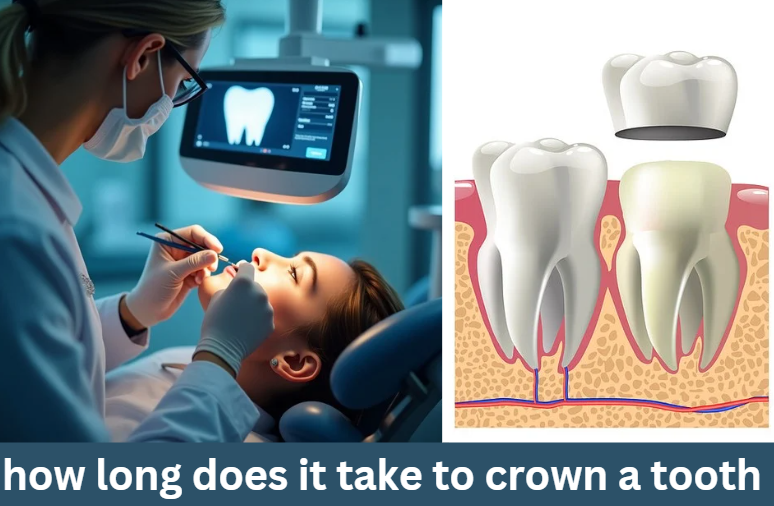In-Depth Guide: how long does it take to crown a tooth – Procedures, Factors, and Patient Insights
Dental crowns are custom-made caps that restore the shape, size, and strength of a tooth. They not only protect compromised teeth but also enhance their appearance.
Knowing how long does it take to crown a tooth is crucial for planning your dental visits and managing your expectations. This guide explains the complete process—from initial consultation and tooth preparation to final placement and aftercare—ensuring you are well-informed before undergoing the procedure.
Overview of Dental Crowns
A dental crown is designed to cover and protect a tooth that has been weakened by decay, fractures, or after root canal therapy. These crowns can be made from various materials such as porcelain, metal, or ceramic, with each type offering its own advantages.
The procedure typically involves two main approaches: the traditional two-visit process and the modern same-day crown procedure using CAD/CAM technology. Understanding how long does it take to crown a tooth helps in deciding which method suits your dental needs best.
Detailed Crown Procedures
Traditional Two-Visit Process
The conventional method for placing a crown involves two separate visits to your dentist. During the first visit, the dentist examines and prepares the affected tooth by removing a small amount of its outer structure.
This is essential to ensure that the new crown will fit properly. After the tooth is shaped, an impression is taken to create a custom mold. To protect the prepared tooth, a temporary crown is placed immediately. The impression is then sent to a dental laboratory, where the permanent crown is fabricated—a process that generally takes about two weeks.
A table summarizing the traditional process is provided below:
| Step | Description | Typical Timeframe |
|---|---|---|
| Tooth Preparation | Examination, enamel removal, and impression taking | 1-2 hours |
| Temporary Crown Placement | Immediate fitting of a provisional crown | Immediately after prep |
| Laboratory Fabrication | Custom crown creation at a dental lab | Approximately 2 weeks |
| Final Crown Placement | Removal of temporary crown and placement of permanent crown | 1-2 hours |
Same-Day Crown Procedures
Advancements in dental technology have paved the way for same-day crown procedures. Using CAD/CAM systems, such as CEREC, dentists can complete the entire process in one appointment. The process begins with a digital scan of your tooth, which eliminates the need for traditional molds.
The computer then designs the crown, and an in-office milling machine fabricates it right away. This streamlined approach means that you can leave the clinic with your new crown in a single visit, which usually lasts between 2 to 3 hours.
Some benefits of the same-day crown procedure include:
- Reduced overall treatment time and fewer dental visits
- Immediate restoration, allowing you to avoid temporary crowns
- The convenience of advanced digital technology for a precise fit
Factors Affecting Treatment Time
Several factors can influence how long does it take to crown a tooth. One key factor is the condition of the tooth itself; a tooth that requires additional treatments, such as root canal therapy, may extend the overall time needed for the crown procedure.
The type of crown material chosen can also play a role—porcelain crowns, for example, may require more precise adjustments than metal crowns. Additionally, the dentist’s expertise and the availability of advanced equipment, like CAD/CAM systems, are important in determining the treatment time.
Patient Preparation and Expectations
Before undergoing a crown procedure, it is essential to have a thorough consultation with your dentist. During this consultation, you will discuss your dental history, the condition of the tooth, and the best treatment options available. Understanding how long does it take to crown a tooth helps you prepare mentally and logistically for your appointments.
During the procedure, you might experience local anesthesia to ensure comfort. Patients generally feel minimal discomfort during both the preparation and the placement of the crown. After the procedure, your dentist will provide aftercare instructions, such as avoiding hard foods for a few days and maintaining good oral hygiene to ensure the crown’s longevity.
Pros and Cons: Traditional vs. Same-Day Crowns
Deciding between the traditional and same-day methods involves weighing several factors. Traditional crowns offer a time-tested process with a custom laboratory finish that many patients appreciate for its durability and aesthetic quality.
However, this method requires multiple visits, which can be inconvenient for some patients. In contrast, same-day crowns offer the advantage of completing the procedure in one appointment, saving time and reducing the need for temporary crowns. Yet, this option is only available in practices equipped with advanced digital technology.
Comparative Analysis with Competitor Guides
Our guide on how long does it take to crown a tooth is designed to be more comprehensive and reader-friendly compared to competitor content. It not only explains the procedures in depth but also covers influencing factors and patient care aspects, ensuring that you have all the information needed for an informed decision.
Below is a comparison table:
| Feature | Competitor Guides | This Comprehensive Guide |
|---|---|---|
| Depth of Information | Basic overview | Detailed explanation of both traditional and same-day procedures, with patient preparation and aftercare insights |
| Clarity and Readability | Heavy on technical jargon | Balanced use of simple language, lists, and tables for clear understanding |
| Coverage of Technological Advances | Limited mention of CAD/CAM technology | In-depth discussion of same-day crown technology and its benefits |
| Practical Tips for Patients | Minimal guidance | Extensive advice on preparation, expectations, and aftercare |
Future Trends and Innovations in Dental Crowns
The field of dental restorations continues to evolve with ongoing research and technological advancements. Future improvements may further reduce treatment times, improve the durability and aesthetics of crowns, and expand the accessibility of same-day procedures.
Innovations in materials science and digital dentistry are expected to make crown procedures even more efficient and effective, potentially reshaping how long does it take to crown a tooth in the near future.
Frequently Asked Questions
What are some potential complications during or after a dental crown procedure?
While dental crown procedures are generally safe, some patients may experience complications such as sensitivity, minor discomfort, or inflammation after the procedure. In rare cases, issues like improper fit or allergic reactions to crown materials may occur. It is important to discuss your medical history and any concerns with your dentist to minimize risks.
How much does a dental crown typically cost, and what factors influence the price?
The cost of a dental crown can vary widely depending on the materials used (porcelain, metal, or ceramic), the complexity of the procedure, and the location of the dental practice. Additionally, the need for any supplementary treatments, such as root canals or additional tooth preparation, can affect the overall expense.
What are the best practices for maintaining a dental crown once it has been placed?
To extend the life of your dental crown, maintaining excellent oral hygiene is essential. This includes regular brushing, flossing, and professional dental cleanings. Additionally, avoiding excessive pressure from hard foods and refraining from habits like teeth grinding can help preserve the crown’s integrity over time.
Will dental insurance typically cover the cost of a crown procedure?
Coverage for dental crowns varies depending on your dental insurance plan. Many insurance policies offer partial coverage for restorative procedures like crowns, especially if the work is deemed medically necessary. It is advisable to check with your provider for details on coverage limits, co-pays, and any pre-authorization requirements.
What alternatives exist if I decide not to have a crown placed on a damaged tooth?
If you choose not to pursue a crown, there are alternative treatments available. Options may include dental fillings, onlays, or even dental bonding, depending on the severity of the damage. In more advanced cases, your dentist might recommend other restorative options such as dental bridges or implants as suitable alternatives.
Conclusion
In conclusion, understanding how long does it take to crown a tooth is key to managing your expectations and planning your dental care. Whether you choose the traditional two-visit process or opt for the convenience of a same-day procedure, being well-informed helps you make the best decision for your oral health.
This guide has explored every aspect of the crown procedure—from initial consultation and tooth preparation to patient aftercare and future innovations—offering a complete resource for anyone considering a dental crown. By providing detailed insights and practical tips, we hope to empower you with the knowledge needed to navigate your dental restoration journey with confidence.
Read more
Comprehensive Guide to janlukcs contratistas generales e.i.r.l.
Comprehensive Guide to alfani step n flex – Comfort, Style, and Innovation
Club penguin journey elf on the shelf: The Ultimate Guide
In-Depth Guide to the adventure medical kits rapidpure purifier water bottle 1 unit





